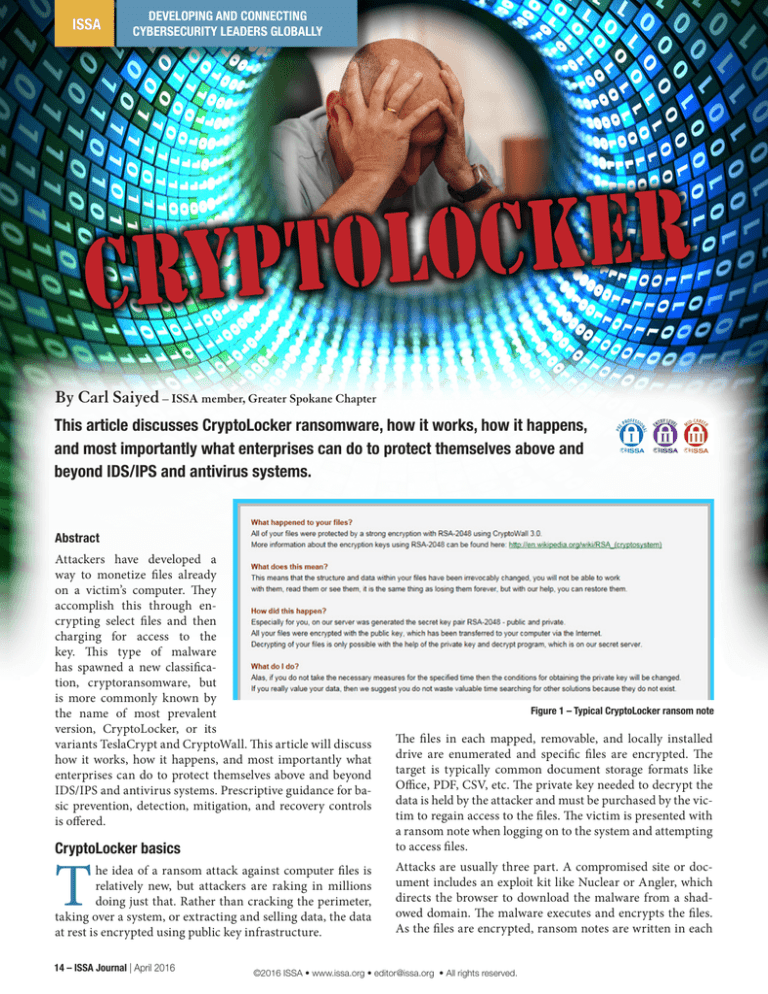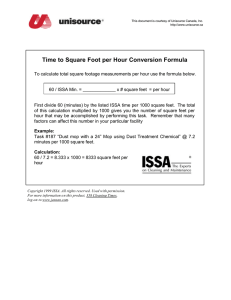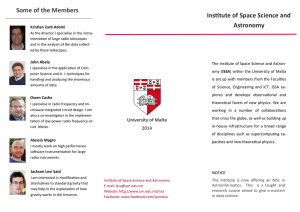
ISSA
DEVELOPING AND CONNECTING
CYBERSECURITY LEADERS GLOBALLY
r
e
k
c
o
L
o
t
p
Cry
By Carl Saiyed – ISSA member, Greater Spokane Chapter
This article discusses CryptoLocker ransomware, how it works, how it happens,
and most importantly what enterprises can do to protect themselves above and
beyond IDS/IPS and antivirus systems.
Abstract
Attackers have developed a
way to monetize files already
on a victim’s computer. They
accomplish this through encrypting select files and then
charging for access to the
key. This type of malware
has spawned a new classification, cryptoransomware, but
is more commonly known by
the name of most prevalent
version, CryptoLocker, or its
variants TeslaCrypt and CryptoWall. This article will discuss
how it works, how it happens, and most importantly what
enterprises can do to protect themselves above and beyond
IDS/IPS and antivirus systems. Prescriptive guidance for basic prevention, detection, mitigation, and recovery controls
is offered.
CryptoLocker basics
T
he idea of a ransom attack against computer files is
relatively new, but attackers are raking in millions
doing just that. Rather than cracking the perimeter,
taking over a system, or extracting and selling data, the data
at rest is encrypted using public key infrastructure.
14 – ISSA Journal | April 2016
Figure 1 – Typical CryptoLocker ransom note
The files in each mapped, removable, and locally installed
drive are enumerated and specific files are encrypted. The
target is typically common document storage formats like
Office, PDF, CSV, etc. The private key needed to decrypt the
data is held by the attacker and must be purchased by the victim to regain access to the files. The victim is presented with
a ransom note when logging on to the system and attempting
to access files.
Attacks are usually three part. A compromised site or document includes an exploit kit like Nuclear or Angler, which
directs the browser to download the malware from a shadowed domain. The malware executes and encrypts the files.
As the files are encrypted, ransom notes are written in each
©2016 ISSA • www.issa.org • editor@issa.org • All rights reserved.
CryptoLocker | Carl Saiyed
directory (see figure 1). Often, a randomly generated
registry key is created and keeps a record of all encrypted files.
Once infected, a user has four options:
1. Pay the ransom
2. Restore from backup
3. Lose the files
4. Brute force the key
To brute force the key would require factoring
617-digit numbers, which would take about 6.4
quadrillion years on a standard desktop computer
[1]. This effectively takes brute forcing off the menu
for most environments. The attack relies on public
key cryptography, in which the private key needed
to decrypt the data never actually exists on the victim’s machine. The public key used to encrypt is all
but worthless as it relates to decrypting the files. The
cryptographic strength of the RSA algorithm is by
design and is ordinarily used to secure web communications. For purposes of this article, brute forcing
the key is not considered a legitimate recovery control.
If the victim decides to pay, the attacker typically
requests payment using Bitcoin. At the time of this
writing, the average ransom was between $500-750 USD. The
value of the ransom will change depending on the number of
encrypted files. If the victim fails to pay within the allotted
time, the ransom will double or triple. Some versions offer
to decrypt one file for free. Most variants offer free technical
support if the victim is unable to decrypt after paying. Most
variants do actually return the private key once the ransom is
paid. Users can access the ransom page from the link in the
ransom note (see figure 2).
Figure 2 – Typical CryptoLocker ransom page
Some reports suggest that up to .4% [2] of enterprises and
home users will pay the ransom. In some cases, even police
departments have been victims and, due to lack of proper
backups, have had to pay the ransom to retrieve their files.
The FBI reports that between April 2014 and June 2015, victims reported losses of over $18 million [3].
If the victim can restore from backup, this is ideal. But for
home users, this is not always the case. Many users choose to
backup to removable media such as a USB hard drive. These,
©2016 ISSA • www.issa.org • editor@issa.org • All rights reserved.
April 2016 | ISSA Journal – 15
CryptoLocker | Carl Saiyed
if left attached, will ordinarily also be encrypted with the infection. A USB drive attached to the computer but turned off
or without power is likely safe, provided it is not powered over
USB. Most users and enterprises will elect to lose the files that
cannot be recovered from backup.
No matter what method is used post-infection—paying the
ransom, restoring the files from backup, or deciding to lose
the files—the operating system of the infected computer
should always be re-installed in order to ensure a clean start.
How it happens
What is especially impressive is not just that attackers would
be so bold as to launch the attack, charge for the key, and provide technical support, but the relative ease with which these
attacks succeed. This has become a true revenue stream, and
the attackers are able to develop very sophisticated, clever
ways to deliver their malware. The most common infection
mechanisms are malicious Office documents and drive-by
downloads.
Email is still a vector
The malicious office documents typically are part of an email
claiming to be a fax or an invoice. The user opens the document and the text of the document claims that the document
is protected and cannot be viewed. However, the document
comes to the rescue with instructions on how to enable the
content: just follow the steps to enable macros (see figure 3).
Once the user follows the steps, the macro runs, the payload
is delivered, and infection will commence. A variant of this is
to include a zipped copy of the malicious script in hopes the
user has a file association that will run the script when unzipped. Both versions rely heavily on script obfuscation techniques, so a manual or automated code review won’t catch
these. In some cases, the Office document is zipped; in some
cases it is attached directly. Usually the filename includes .doc
to mask the actual extension, .docm.
It’s not just “bad” sites anymore
With the advent of content aggregating sites, users are increasingly able to visit a vast array of sites in relatively short
order. Frequently, this includes personal blogs used to share
ideas, most of which are built with standard templates and
are not held to the same rigorous security standards that
many corporate websites are held to. These sites have legit-
Figure 3 – An malicious Word document with instructions to enable macros
16 – ISSA Journal | April 2016
Figure 4 – A personal blog that suffered an attack that delivered
CryptoLocker to visitors
imate content and in and of themselves are not only harmless but often useful (see figure 4). Users aren’t typically on
guard with sites like these because they appear to be totally
innocent. These, along with ads, are a typical source of driveby downloads. Attackers need only infect a blog and wait for
users to visit that page. Typically, the compromised site will
include JavaScript that loads a malicious Flash movie that
runs in the background, takes advantage of an exploit within
Flash, and downloads the malware.
In both cases, the actual malware is usually delivered from
a randomly generated subdomain of a legitimate domain.
Attackers will compromise the DNS account for a domain
and register different subdomains, then use those for attack.
Often, these subdomains are only used once. This has been
dubbed “domain shadowing” by Nick Biasini [4].
Defense strategies
Preventing this type of infection is difficult. The attackers
go to great length to hide the actual malware from analysis.
The code is obfuscated. Shadowed domains are typically only
used once for a given victim’s public IP. The infection binary is removed when the encryption is complete. Most of the
owners of sites actually delivering the malware have no idea
that an infection has even occurred. Typical antivirus suites
are ineffective until the machine is well beyond the
event horizon.
Assuming an enterprise already has appropriate, updated email security and web browsing mechanisms
in place, there are few additional protection steps that
can be taken. Some firewall/IPS/IDS and web proxy
solutions can be effective but leave an enterprise in the
middle of the cat-and-mouse game of attacker-vs-vendor, waiting for updated signatures or definitions.
Rather, it can be useful to employ a more active posture against this type of attack, of which there are four
main protection mechanisms. To this end, I offer the
following prescriptive guidance.
©2016 ISSA • www.issa.org • editor@issa.org • All rights reserved.
CryptoLocker | Carl Saiyed
Preventive controls
First, if at all possible, disallow Flash for untrusted websites.
This has some initial overhead while whitelisted websites are
identified, but the ActiveX filtering feature in Internet Explorer has proven to be effective. Couple this with disabling Flash
in Chrome and Firefox. Identify and implement a formal
help-desk process to add sites to the whitelist. Ensure only
knowledgeable personnel can approve adding to the whitelist.
Second, filter inbound email for attached ZIP and Microsoft
Office documents. Consider blocking macro-enabled Office
documents altogether. Often, the majority of inbound emails
that match this filter are malicious and never need to reach a
user’s inbox. Additionally, continue the message and inform
the user that the attachment was filtered; identify and implement a formal help-desk process whereby users can request
the attachment after it has been screened. An enterprise may
consider whitelisting for this as well.
Third, disable macros within the Office suite. It may be appropriate to enable with notification or disable altogether.
The former will give the user the ability to override and execute the macro, while the latter requires administrator intervention. Both can be installed using Group Policy.
Fourth, and most difficult to implement, is application whitelisting. There are several commercial products that can
help with this. These can be restricted to only allow certain
binaries to execute. This has the highest level of overhead to
implement and should be a last line of defense.
The second is a quality intrusion detection system. These
usually aren’t able to detect the actual payload on its way to
the host but can often recognize the pattern and alert an administrator. A savvy administrator
or help desk can help to quickly
contain an infection based on such
Detecting the
alerts. Consider coupling an intruincident based on a
sion detection with a SEIM to better
investigate attacks.
user noticing is not
Mitigation controls
reliable and spends
precious time.
It seems almost a foregone conclusion that an enterprise will have
at least some exposure to CryptoLocker and variants. Thankfully, the mitigation and recovery strategies are nothing new to seasoned IT professionals.
These tactics are effective policies, principle of least privilege,
and adequate backups. These concepts are at the core of defending against countless attacks.
A policy regarding storage of important data on network
shares can ease this burden in two ways. A centralized backup is a lot easier to schedule and restore rather than individual workstations and can relieve the IT department of trying to
restore files lost on an actual infected desktop. Typically, files
lost to CryptoLocker on a network share are covered by an
enterprise backup solution and are relatively easy to recover
while the files on the local desktop are lost. Try to tip the odds
Detective controls
Detecting the incident based on a user noticing is not reliable
and spends precious time.
The ransom note doesn’t open automatically for the user until
the encryption process is complete. Depending on the speed
of the infected machine and the resources to which it has
access, the actual encryption process can take days. Worse
yet, the encryption happens in the background and the user
might leave for vacation. Frequently, IT isn’t notified until the
user calls because his computer isn’t working properly. Such
an infection can avoid detection longer than some backups
are held. Effective detection mechanisms can help stop an
attack earlier. There are two primary detective mechanisms.
Adaptive
Segmentation
Eliminates the
Attack Surface.
See how. Visit us at www.illumio.com/ISSA
The first mechanism is an enterprise data management solution. Most CryptoLocker variants will leave small traces behind in each directory where encryption has taken place, usually a variant of files name “HELP_DECRYPT.” Enterprise
data management solutions can monitor for the creation of
these files and even take an action such as disabling the user’s
Active Directory account if these files are detected.
These systems can also detect substantial data access patterns,
consistent with CryptoLocker enumerating directories looking for files to encrypt. Lastly, they can assist with post-infection investigations, including identifying the time and date of
the infection and which files were encrypted.
©2016 ISSA • www.issa.org • editor@issa.org • All rights reserved.
April 2016 | ISSA Journal – 17
CryptoLocker | Carl Saiyed
in your favor by requiring users to store important files where
they are most easily backed up and restored.
Users with low-permission accounts will simply lack the
write privileges required to perform the delete and encrypt
functions that CryptoLocker relies on. A user lacking vast
permissions will only be able to commit a small amount of
damage. Apply only the minimum amount of permissions required for users to complete their job function. Consider creating separate accounts to be used for high-privilege operations and documenting their appropriate use. Enterprise data
management can help provide a framework to understand
data ownership and over-permissive folders and accounts.
Recovery controls
Lastly, frequent and reliable backups are key. Once the attack
is successful, this is the most reliable recovery mechanism.
Ensure that a recovery point objective has been considered
for network files and shares. A careful review may show that
this area has been overlooked and is actually mission critical.
Consider both the files that could be lost as well as the loss
of availability of the share, drive, or server. Once the critical
file resources are identified, implement appropriate backup
mechanisms. Ensure restore mechanisms are tested and staff
responsible for restoring data are properly trained.
Conclusion
Persistent attackers have created a lucrative and effective
threat. The right combination of prevention, detection, mitigation, and recovery strategies can help ensure that a wouldbe disaster is instead an annoyance. Hopefully, enterprises
armed with an understanding of CryptoLocker fundamentals and practical security measures will be better poised to
defend against it.
Don’t Miss This Web Conference!
The Sky Is Falling...
CVE-2016-9999(nth)?
2-Hour Live Event: Tuesday, April, 2016
9a.m. US-Pacific/ 12p.m. US-Eastern/ 5p.m. London
Since its creation the US National Vulnerability
Database there have been 75,451 CVEs posted. So
far this year there have been 846 CVEs. When will
it stop? Are there any strategies to mitigate the
impact of the vulnerabilities?
REGISTER TODAY!
For more information on this or other webinars:
ISSA.org => Web Events => International Web Conferences
18 – ISSA Journal | April 2016
References
1. The Math behind Estimations to Break a 2048-bit Certificate, Digicert – https://www.digicert.com/TimeTravel/
math.htm.
2. Lee Mathews, CryptoLocker Malware Masterminds
Make around $30 Million in Ransom in 100 days, Geek.
com – http://www.geek.com/news/CryptoLocker-malware-masterminds-make-around-30-million-in-ransom-in-100-days-1580168/.
3. Darrell Foxworth, FBI Warns Public of Cryptowall Ransomware schemes, FBI – https://www.fbi.gov/sandiego/
press-releases/2015/fbi-warns-public-of-cryptowall-ransomware-schemes.
4. Nick Biasini, Angler Lurking in the Domain Shadows,
Iron Geek – http://www.irongeek.com/i.php?page=videos/bsideslasvegas2015/cg04-angler-lurking-in-the-domain-shadows-nick-biasini.
General references
—Haws, John, US local Police Department Pays CryptoLocker Ransom, Sophos – https://nakedsecurity.sophos.
com/2013/11/19/us-local-police-department-pays-CryptoLocker-ransom/.
—IBM, IBM X-Force Threat Intelligence Quarterly, 1Q 2015,
IBM – http://public.dhe.ibm.com/common/ssi/ecm/wg/en/
wgl03073usen/WGL03073USEN.PDF.
—Jeffers, Dave, Crime Pays Very Well: CryptoLocker
GRosses up to $30 Million in Ransom, PCworld – http://
www.pcworld.com/article/2082204/crime-pays-very-wellCryptoLocker-grosses-up-to-30-million-in-ransom.html.
—NSA, Application Whitelisting Using Software Restriction
Policies, NSA Information Assurance Directorate – https://
www.nsa.gov/ia/_files/os/win2k/Application_Whitelisting_Using_SRP.pdf.
—Snow, John, TeslaCrypt: Round Three, Kaspersky Labs –
https://blog.kaspersky.com/teslacrypt-strikes-again/10860/.
—Villeneuve, Nart, TeslaCrypt: Following the Money Trail
and Learning the Human Costs of Ransomware, FireEye
– https://www.fireeye.com/blog/threat-research/2015/05/
teslacrypt_followin.html.
—Zorabedian, John, Anatomy of a Ransomware Attack,
Sophos –https://blogs.sophos.com/2015/03/03/anatomy-of-a-ransomware-attack-CryptoLocker-cryptowall-and-how-to-stay-safe-infographic/.
—Zorabedian, John, Did the FBI Really Say “Pay Up” for
Ransomware? Sophos – https://nakedsecurity.sophos.
com/2015/10/28/did-the-fbi-really-saypay-up-for-ransomware-heres-whatto-do/.
About the Author
Carl Saiyed, CISSP, is a full-time security
analyst in critical infrastructure sectors.
Find Carl on Twitter (@nothackingyou)
or LinkedIn. He may be reached at carlsaiyed@gmail.com.
©2016 ISSA • www.issa.org • editor@issa.org • All rights reserved.





